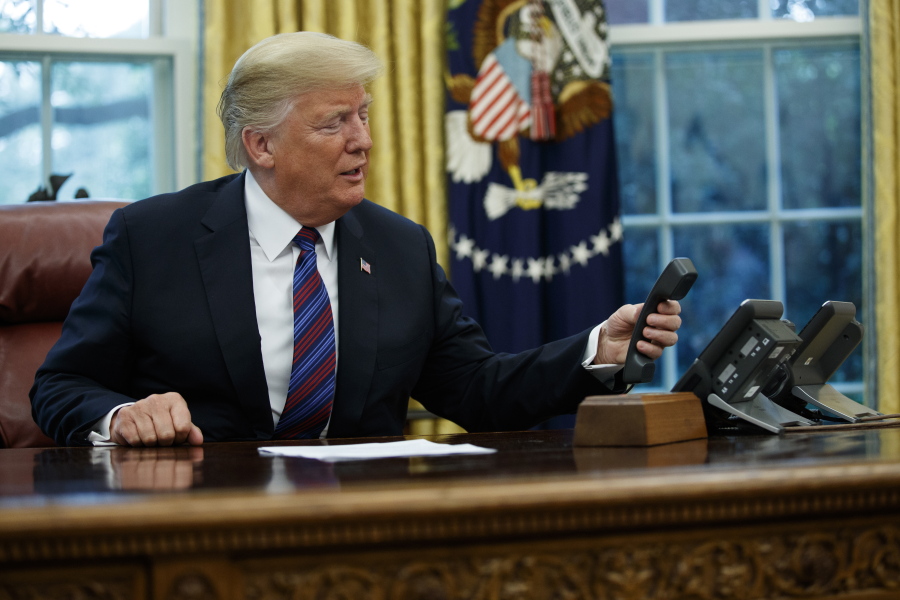President Donald Trump on Monday claimed he’d made a major breakthrough in trade relations between the United States and Mexico — suggesting he’d reached a deal to replace the North American Free Trade Agreement.
But the administration’s own description calls the deal a “preliminary agreement in principle.” That’s not a finished product, and it can’t become one without clearing the high hurdles of approval from Congress and Mexico.
NAFTA also includes Canada, a country conspicuously absent from Monday’s announcement and whose officials have clashed repeatedly with Trump on trade.
Monday’s deal could become a big win for Trump, but hard negotiations await. Here’s a rundown of what’s in the deal — and the many hurdles to clear before it becomes final.
• What’s in the deal?: Broadly, the deal aims to update the 1993 agreement and spur more auto manufacturing in the United States and Mexico. It covers many things, including car, intellectual property and labor rights. Several trade experts noted that many provisions in Monday’s agreement resemble what was in President Barack Obama’s Trans-Pacific Partnership, a deal Trump pulled out of as soon as he took office.
New rules for automobiles: Under the deal, to escape tariffs, 75 percent of “auto content” — car parts and amenities — must be made within the United States or Mexico. That would be a bump from the existing 62.5 percent minimum of North American content, a boost aimed at creating automobile industry jobs domestically, rather than in Asia.
• New rules for auto wages: In addition, the rules stipulate that 40 to 45 percent of the auto content must be made by workers earning more than $16 per hour. The average hourly pay for a U.S. autoworker is more than $22 an hour, according to the Labor Department, but $16 is huge for Mexico, where auto parts workers average less than $3.50 an hour, according to the Center for Automotive Research. This provision is considered a win for Trump, since Mexico had been advocating a much smaller percentage.
• New rules for intellectual property, the environment and labor: Nearly everyone agreed that NAFTA needed to be updated for the digital economy. This agreement would make it harder for intellectual property theft. The deal also requires Mexico to do more to allow collective bargaining for workers and to protect air quality and marine wildlife, including whales and sea turtles. These provisions were all part of TPP, which Mexico and Canada both signed onto after Trump took the United States out of that deal.
• How long would it last?: The United States and Mexico agreed to revisit the deal after six years, and if everyone is pleased, to extend it for 16 years. If some sides are not happy, there would be a new round of negotiations.
• What would this mean for most Americans?: If the deal clears the many hurdles it would need to to go into effect, it would likely make cars and trucks more expensive for American buyers. Some economists also warn a U.S.-Mexico deal that doesn’t include Canada would be very confusing (and expensive) for businesses to navigate, potentially costing jobs or shifting them overseas. On the upside, White House officials hope the agreement will create more North American jobs by making it harder for countries like China to ship cheap products through Mexico and on to the United States.
• What’s not in the deal?: The deal does not resolve the tariffs the Trump administration put on steel and aluminum earlier this year, taxes that have proved a major sticking point in trade relations and led to Mexican retaliation against U.S. goods. The deal also does not resolve a broader issue over what are known as “232 tariffs,” taxes on foreign goods the Trump administration has imposed in the name of national security. The administration used that process for the steel and aluminum tariffs, over the strong objections of many U.S. allies and trading partners — including Canada. And Trump is considering 232 tariffs on foreign autos.
• What happened to Canada?: Canada is part of NAFTA, but it was not included in the U.S.-Mexico agreement announced Monday. Trump said Monday that “we’ll see” if Canada can join the agreement. Canada’s foreign affairs minister, Chrystia Freeland, is coming to Washington this week to talk trade.
Trump is pressing Canada to join the pact, and he threatened hefty tariffs on Canadian cars and auto parts if it won’t join. But Canadian officials say their country, which has already been hit by Trump’s steel tariffs and retaliated against them, won’t join any deal that hurts their workers and businesses.
• Does Congress need to approve the deal?: Yes. Trump would have to formally submit a deal to Congress, which would have 90 days to make an up-or-down decision on it. And what Congress members are willing to approve may have a lot to do with how talks go with Canada.



